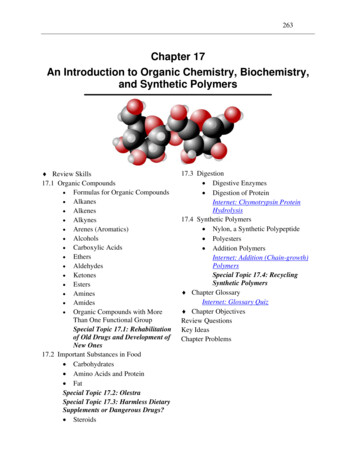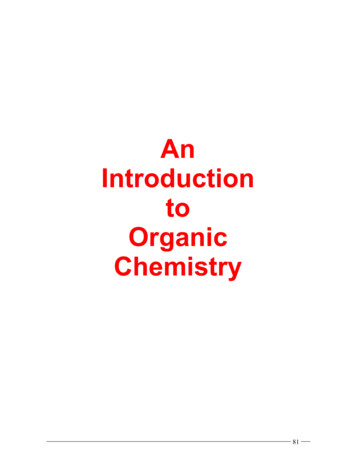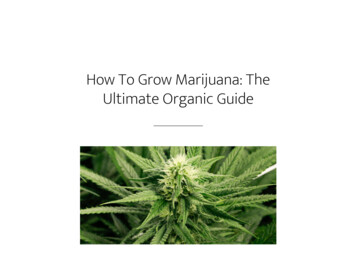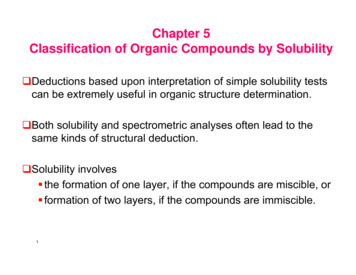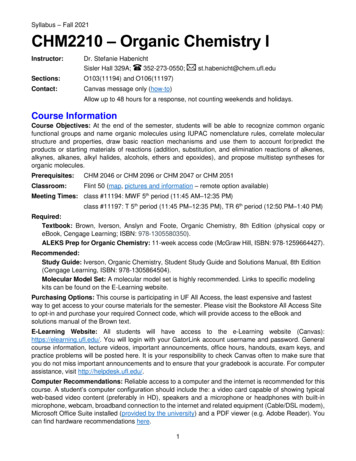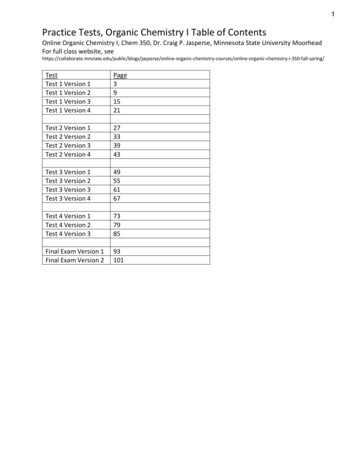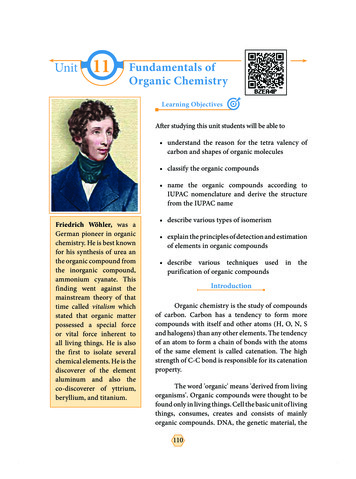
Transcription
Licensed to: CengageBrain User
Licensed to: CengageBrain UserThis is an electronic version of the print textbook. Due to electronic rights restrictions,some third party content may be suppressed. Editorial review has deemed that any suppressedcontent does not materially affect the overall learning experience. The publisher reserves the rightto remove content from this title at any time if subsequent rights restrictions require it. Forvaluable information on pricing, previous editions, changes to current editions, and alternateformats, please visit www.cengage.com/highered to search by ISBN#, author, title, or keyword formaterials in your areas of interest.Copyright 2011 Cengage Learning. All Rights Reserved. May not be copied, scanned, or duplicated, in whole or in part. Due to electronic rights, some third party content may be suppressed from the eBook and/or eChapter(s).Editorial review has deemed that any suppressed content does not materially affect the overall learning experience. Cengage Learning reserves the right to remove additional content at any time if subsequent rights restrictions require it.
Licensed to: CengageBrain UserIntroduction to General, Organic,and Biochemistry, Tenth EditionFrederick A. Bettelheim, William H.Brown, Mary K. Campbell, Shawn O. Farrell,Omar J. TorresPublisher: Mary FinchDevelopmental Editor: Sandra Kiselica 2013, 2010 Brooks/Cole, Cengage LearningALL RIGHTS RESERVED. No part of this work covered by the copyright hereinmay be reproduced, transmitted, stored or used in any form or by any meansgraphic, electronic, or mechanical, including but not limited to photocopying,recording, scanning, digitizing, taping, Web distribution, information networks,or information storage and retrieval systems, except as permitted underSection 107 or 108 of the 1976 United States Copyright Act, without the priorwritten permission of the publisher.Assistant Editor: Elizabeth WoodsEditorial Assistant: Krista MastroianniSenior Media Editor: Lisa WeberMedia Editor: Stephanie VanCampMarketing Manager: Nicole HammMarketing Assistant: Julie StefaniFor product information and technology assistance, contact us atCengage Learning Customer & Sales Support, 1-800-354-9706For permission to use material from this text or product,submit all requests online at cengage.com/permissionsFurther permissions questions can be emailed topermissionrequest@cengage.comMarketing Communications Manager: Linda YipContent Project Manager: Teresa L. TregoLibrary of Congress Control Number: 2011934948Design Director: Rob HugelISBN-13: 978-1-133-10508-4Art Director: Maria EpesISBN-10: 1-133-10508-4Manufacturing Planner: Karen HuntRights Acquisitions Specialist: Dean DauphinaisProduction Service: PreMediaGlobalText Designer: Bill Reuter DesignBrooks/Cole20 Davis DriveBelmont, CA 94002-3098USAPhoto Researcher: Chris Altof/Bill Smith GroupText Researcher: Sue C. HowardCopy Editor: PreMediaGlobalIllustrator: PreMediaGlobal, 2064 DesignOWL Producers: Stephen Battisti, Cindy Stein,David Hart (Center for Educational SoftwareDevelopment, University of Massachusetts,Amherst)Cover Designer: Bill Reuter DesignCover Images: Main image Dave Reede/GettyImages, from left to right Ottmar Diez/GettyImages, Chris Hill/Getty Images, David Norton Photography/Alamy, PhotoResearchers, Inc.Cengage Learning is a leading provider of customized learning solutions withoffice locations around the globe, including Singapore, the United Kingdom,Australia, Mexico, Brazil, and Japan. Locate your local office at:www.cengage.com/globalCengage Learning products are represented in Canada by Nelson Education, Ltd.For your course and learning solutions, visit academic.cengage.comPurchase any of our products at your local college store or at our preferredonline store www.cengagebrain.comCompositor: PreMediaGlobalUnless otherwise noted, all art appearing in this book is Cengage Learning 2013.Printed in the United States of America1 2 3 4 5 6 7 15 14 13 12 11Copyright 2011 Cengage Learning. All Rights Reserved. May not be copied, scanned, or duplicated, in whole or in part. Due to electronic rights, some third party content may be suppressed from the eBook and/or eChapter(s).Editorial review has deemed that any suppressed content does not materially affect the overall learning experience. Cengage Learning reserves the right to remove additional content at any time if subsequent rights restrictions require it.
Licensed to: CengageBrain User1Matter, Energy,and MeasurementKey Questions1.1 Why Do We Call Chemistrythe Study of Matter?1.2 What Is the Scientific Method?1.3 How Do Scientists ReportNumbers?James Balog/Getty ImagesHow To . . . Determine theNumber of Significant Figuresin a NumberA woman climbing a frozen waterfall in British Columbia.1.4 How Do We MakeMeasurements?1.5 What Is a Handy Way toConvert from One Unit toAnother?How To . . . Do UnitConversions by the FactorLabel Method1.6 What Are the States of Matter?1.1 Why Do We Call Chemistrythe Study of Matter?The world around us is made of chemicals. Our food, our clothing, thebuildings in which we live are all made of chemicals. Our bodies aremade of chemicals, too. To understand the human body, its diseases,and its cures, we must know all we can about those chemicals. There wasa time—only a few hundred years ago—when physicians were powerlessto treat many diseases. Cancer, tuberculosis, smallpox, typhus, plague, andmany other sicknesses struck people seemingly at random. Doctors, whohad no idea what caused any of these diseases, could do little or nothingabout them. Doctors treated them with magic as well as by such measuresas bleeding, laxatives, hot plasters, and pills made from powdered staghorn, saffron, or gold. None of these treatments was effective, and the doctors, because they came into direct contact with highly contagious diseases,died at a much higher rate than the general public.1.7 What Are Density andSpecific Gravity?1.8 How Do We Describe theVarious Forms of Energy?1.9 How Do We Describe Heatand the Ways in Which It IsTransferred?Sign in to OWL atwww.cengage.com/owlto view tutorials andsimulations, developproblem-solving skills,and complete onlinehomework assigned byyour professor.Copyright 2011 Cengage Learning. All Rights Reserved. May not be copied, scanned, or duplicated, in whole or in part. Due to electronic rights, some third party content may be suppressed from the eBook and/or eChapter(s).Editorial review has deemed that any suppressed content does not materially affect the overall learning experience. Cengage Learning reserves the right to remove additional content at any time if subsequent rights restrictions require it.
Licensed to: CengageBrain UserChapter 1Matter, Energy, and MeasurementCourtesy of the National Library of MedicineMedical practice over time.(a) A woman being bled by a leech onher left forearm; a bottle of leeches ison the table. From a 1639 woodcut.(b) Modern surgery in a well-equippedoperating room.Photo by Bob Riha, Jr. Used courtesy of Childrens HospitalLos Angeles.2(a)(b)Medicine has made great strides since those times. We live much longer, and many once-feared diseases have been essentially eliminated or arecurable. Smallpox has been eradicated, and polio, typhus, bubonic plague,diphtheria, and other diseases that once killed millions no longer pose aserious problem, at least not in the developed countries.How has this medical progress come about? The answer is that diseasescould not be cured until they were understood, and this understanding hasemerged through greater knowledge of how the body functions. It is progress in our understanding of the principles of biology, chemistry, and physics that has led to these advances in medicine. Because so much of modernmedicine depends on chemistry, it is essential that students who intend toenter the health professions have some understanding of basic chemistry.This book was written to help you achieve that goal. Even if you choosea different profession, you will find that the chemistry you learn in thiscourse will greatly enrich your life.The universe consists of matter, energy, and empty space. Matter is anything that has mass and takes up space. Chemistry is the science thatdeals with matter: the structure and properties of matter and the transformations from one form of matter to another. We will discuss energy inSection 1.8.It has long been known that matter can change, or be made to change,from one form to another. In a chemical change, more commonly calleda chemical reaction, substances are used up (disappear) and others areformed to take their places. An example is the burning of the mixture ofhydrocarbons usually called “bottled gas.” In this mixture of hydrocarbons,the main component is propane. When this chemical change takes place,propane and oxygen from the air are converted to carbon dioxide and water.Figure 1.1 shows another chemical change.Matter also undergoes other kinds of changes, called physical changes.These changes differ from chemical reactions in that the identities of thesubstances do not change. Most physical changes involve changes of state—for example, the melting of solids and the boiling of liquids. Water remainswater whether it is in the liquid state or in the form of ice or steam. Theconversion from one state to another is a physical—not a chemical—change.Another important type of physical change involves making or separatingmixtures. Dissolving sugar in water is a physical change.When we talk about the chemical properties of a substance, we meanthe chemical reactions that it undergoes. Physical properties are allproperties that do not involve chemical reactions. For example, density,color, melting point, and physical state (liquid, solid, gas) are all physicalproperties.Copyright 2011 Cengage Learning. All Rights Reserved. May not be copied, scanned, or duplicated, in whole or in part. Due to electronic rights, some third party content may be suppressed from the eBook and/or eChapter(s).Editorial review has deemed that any suppressed content does not materially affect the overall learning experience. Cengage Learning reserves the right to remove additional content at any time if subsequent rights restrictions require it.
Licensed to: CengageBrain User(a)(b)3Charles D. WintersCharles D. WintersCharles D. Winters1.2 What Is the Scientific Method?(c)FIGURE 1.1 A chemical reaction. (a) Bromine, an orange-brown liquid, andaluminum metal. (b) These two substances react so vigorously that the aluminumbecomes molten and glows white hot at the bottom of the beaker. The yellowvapor consists of vaporized bromine and some of the product of the reaction,white aluminum bromide. (c) Once the reaction is complete, the beaker is coatedwith aluminum bromide and the products of its reaction with atmosphericmoisture. (Note: This reaction is dangerous! Under no circumstances should it bedone except under properly supervised conditions.)Galen did not do experiments to testhis hypothesis.Lawrence Berkeley Nat’l Lab – RoyKaltschmidt, photographerScientists learn by using a tool called the scientific method. The heart ofthe scientific method is the testing of theories. It was not always so, however.Before about 1600, philosophers often believed statements just because theysounded right. For example, the great philosopher Aristotle (384–322 BCE)believed that if you took the gold out of a mine it would grow back. Hebelieved this idea because it fitted in with a more general picture that hehad about the workings of nature. In ancient times, most thinkers behavedin this way. If a statement sounded right, they believed it without testing it.About 1600 CE, the scientific method came into use. Let us look at anexample to see how the scientific method operates. The Greek physician Galen (200–130 BCE) recognized that the blood on the left side of theheart somehow gets to the right side. This is a fact. A fact is a statementbased on direct experience. It is a consistent and reproducible observation.Having observed this fact, Galen then proposed a hypothesis to explainit. A hypothesis is a statement that is proposed, without actual proof, toexplain the facts and their relationship. Because Galen could not actuallysee how the blood got from the left side to the right side of the heart, hecame up with the hypothesis that tiny holes must be present in the muscular wall that separates the two halves.Up to this point, a modern scientist and an ancient philosopher wouldbehave the same way. Each would offer a hypothesis to explain the facts.From this point on, however, their methods would differ. To Galen, his explanation sounded right and that was enough to make him believe it, eventhough he couldn’t see any holes. His hypothesis was, in fact, believed byvirtually all physicians for more than 1000 years. When we use the scientific method, however, we do not believe a hypothesis just because it soundsright. We test it, using the most rigorous testing we can imagine.William Harvey (1578–1657) tested Galen’s hypothesis by dissectinghuman and animal hearts and blood vessels. He discovered that one-wayCourtesy of the National Library of Medicine1.2 What Is the Scientific Method?A PET scanner is an example of howmodern scientists do experiments totest a hypothesis.Hypothesis A statement that isproposed, without actual proof,to explain a set of facts and theirrelationshipCopyright 2011 Cengage Learning. All Rights Reserved. May not be copied, scanned, or duplicated, in whole or in part. Due to electronic rights, some third party content may be suppressed from the eBook and/or eChapter(s).Editorial review has deemed that any suppressed content does not materially affect the overall learning experience. Cengage Learning reserves the right to remove additional content at any time if subsequent rights restrictions require it.
Licensed to: CengageBrain User4Chapter 1Matter, Energy, and MeasurementTheory The formulation of anapparent relationship among certainobserved phenomena, which has beenverified. A theory explains manyinterrelated facts and can be usedto make predictions about naturalphenomena. Examples are Newton’stheory of gravitation and the kineticmolecular theory of gases, whichwe will encounter in Section 6.6.This type of theory is also subjectto testing and will be discarded ormodified if it is contradicted bynew facts.valves separate the upper chambers of the heart from the lower chambers.He also discovered that the heart is a pump that, by contracting and expanding, pushes the blood out. Harvey’s teacher, Fabricius (1537–1619), hadpreviously observed that one-way valves exist in the veins, so that blood inthe veins can travel only toward the heart and not the other way.Harvey put these facts together to come up with a new hypothesis: Bloodis pumped by the heart and circulates throughout the body. This was a better hypothesis than Galen’s because it fitted the facts more closely. Evenso, it was still a hypothesis and, according to the scientific method, had tobe tested further. One important test took place in 1661, four years afterHarvey died. Harvey had predicted that because there had to be a way forthe blood to get from the arteries to the veins, tiny blood vessels must connect them. In 1661, the Italian anatomist Malpighi (1628–1694), using thenewly invented microscope, found these tiny vessels, which are now calledcapillaries.Malpighi’s discovery supported the blood circulation hypothesis by fulfilling Harvey’s prediction. When a hypothesis passes the tests, we have moreconfidence in it and call it a theory. A theory is the formulation of an apparent relationship among certain observed phenomena, which has beenverified to some extent. In this sense, a theory is the same as a hypothesisexcept that we have a stronger belief in it because more evidence supportsit. No matter how much confidence we have in a theory, however, if we discover new facts that conflict with it or if it does not pass newly devisedtests, the theory must be altered or rejected. In the history of science, manyfirmly established theories have eventually been thrown out because theycould not pass new tests.One of the most important ways to test a hypothesis is by a controlled experiment. It is not enough to say that making a change causes an effect, wemust also see that the lack of that change does not produce the observed effect.If, for example, a researcher proposes that adding a vitamin mixture to the dietof children improves growth, the first question is whether children in a controlgroup who do not receive the vitamin mixture do not grow as quickly. Comparison of an experiment with a control is essential to the scientific method.The scientific method is thus very simple. We don’t accept a hypothesisor a theory just because it sounds right. We devise tests, and only if the hypothesis or theory passes the tests do we accept it. The enormous progressmade since 1600 in chemistry, biology, and the other sciences is a testimonyto the value of the scientific method.You may get the impression from the preceding discussion that scienceprogresses in one direction: facts first, hypothesis second, theory last. Reallife is not so simple, however. Hypotheses and theories call the attentionof scientists to discover new facts. An example of this scenario is the discovery of the element germanium. In 1871, Mendeleev’s Periodic Table—a graphic description of elements organized by properties—predicted theexistence of a new element whose properties would be similar to those ofsilicon. Mendeleev called this element eka-silicon. In 1886, it was discovered in Germany (hence the name), and its properties were truly similar tothose predicted by theory.On the other hand, many scientific discoveries result from serendipity,or chance observation. An example of serendipity occurred in 1926, whenJames Sumner of Cornell University left an enzyme preparation of jackbean urease in a refrigerator over the weekend. Upon his return, he foundthat his solution contained crystals that turned out to be a protein. Thischance discovery led to the hypothesis that all enzymes are proteins. Ofcourse, serendipity is not enough to move science forward. Scientists musthave the creativity and insight to recognize the significance of their observations. Sumner fought for more than 15 years for his hypothesis to gainCopyright 2011 Cengage Learning. All Rights Reserved. May not be copied, scanned, or duplicated, in whole or in part. Due to electronic rights, some third party content may be suppressed from the eBook and/or eChapter(s).Editorial review has deemed that any suppressed content does not materially affect the overall learning experience. Cengage Learning reserves the right to remove additional content at any time if subsequent rights restrictions require it.
Licensed to: CengageBrain User1.3 How Do Scientists Report Numbers?5acceptance because people believed that only small molecules can formcrystals. Eventually his view won out, and he was awarded a Nobel Prize inchemistry in 1946.1.3 How Do Scientists Report Numbers?Scientists often have to deal with numbers that are very large or very small.For example, an ordinary copper penny (dating from before 1982, when pennies in the United States were still made of copper) contains approximately29,500,000,000,000,000,000,000 atoms of copperand a single copper atom 3 poundwhich is equal to0.000000000000000000000104 gram Skip ODonnell/iStockphoto.comMany years ago, an easy way to handle such large and small numbers wasdevised. This method, which is called exponential notation, is based onpowers of 10. In exponential notation, the number of copper atoms in apenny is written2.95 3 1022and the weight of a single copper atom is written2.3 3 10225 poundwhich is equal to1.04 3 10222 gramThe origin of this shorthand form can be seen in the following examples:Dean Fox / SuperStock100 5 1 3 10 3 10 5 1 3 1021000 5 1 3 10 3 10 3 10 5 1 3 103What we have just said in the form of an equation is “100 is a one with twozeros after the one, and 1000 is a one with three zeros after the one.” We canalso write1/100 5 1/10 3 1/10 5 1 3 10221/1000 5 1/10 3 1/10 3 1/10 5 1 3 1023where negative exponents denote numbers less than 1. The exponent in avery large or very small number lets us keep track of the number of zeros.That number can become unwieldy with very large or very small quantities,and it is easy to lose track of a zero. Exponential notation helps us deal withthis possible source of determinant error.When it comes to measurements, not all the numbers you can generatein your calculator or computer are of equal importance. Only the number ofdigits that are known with certainty are significant. Suppose that you measured the weight of an object as 3.4 g on a balance that you can read to thenearest 0.1 g. You can report the weight as 3.4 g but not as 3.40 or 3.400 gbecause you do not know the added zeros with certainty. This becomes evenmore important when you do calculations using a calculator. For example,you might measure a cube with a ruler and find that each side is 2.9 cm. Ifyou are asked to calculate the volume, you multiply 2.9 cm 3 2.9 cm 3 2.9 cm.The calculator will then give you an answer that is 24.389 cm3. However,your initial measurements were good to only one decimal place, so your finalPhotos showing different orders ofmagnitude.1. Group picnic in stadium parkinglot ( 10 meters)2. Football field ( 100 meters)3. Vicinity of stadium ( 1000 meters).Copyright 2011 Cengage Learning. All Rights Reserved. May not be copied, scanned, or duplicated, in whole or in part. Due to electronic rights, some third party content may be suppressed from the eBook and/or eChapter(s).Editorial review has deemed that any suppressed content does not materially affect the overall learning experience. Cengage Learning reserves the right to remove additional content at any time if subsequent rights restrictions require it.
Licensed to: CengageBrain User6Chapter 1Matter, Energy, and Measurementanswer cannot be good to three decimal places. As a scientist, it is importantto report data that have the correct number of significant figures. A detailed account of using significant figures is presented in Appendix II. Thefollowing How To box describes the way to determine the number of significant figures in a number. You will find boxes like this at places in the textwhere detailed explanations of concepts are useful.How To . . .Determine the Number of SignificantFigures in a Number1. Nonzero digits are always significant.For example, 233.1 m has four significant figures; 2.3 g has twosignificant figures.2. Zeros at the beginning of a number are never significant.For example, 0.0055 L has two significant figures; 0.3456 g has foursignificant figures.3. Zeros between nonzero digits are always significant.For example, 2.045 kcal has four significant figures; 8.0506 g has fivesignificant figures.4. Zeros at the end of a number that contains a decimal point arealways significant.For example, 3.00 L has three significant figures; 0.0450 mm has threesignificant figures.5. Zeros at the end of a number that contains no decimal pointmay or may not be significant.We cannot tell whether they are significant without knowing somethingabout the number. This is the ambiguous case. If you know that a certainsmall business made a profit of 36,000 last year, you can be sure thatthe 3 and 6 are significant, but what about the rest? The profit mighthave been 36,126 or 35,786.53, or maybe even exactly 36,000. We justdon’t know because it is customary to round off such numbers. On theother hand, if the profit were reported as 36,000.00, then all seven digitswould be significant.In science, to get around the ambiguous case, we use exponentialnotation. Suppose a measurement comes out to be 2500 g. If we madethe measurement, then we know whether the two zeros are significant,but we need to tell others. If these digits are not significant, we writeour number as 2.5 3 103. If one zero is significant, we write 2.50 3 103.If both zeros are significant, we write 2.500 3 103. Because we nowhave a decimal point, all the digits shown are significant. We are goingto use decimal points throughout this text to indicate the number ofsignificant figures.Example 1.1 Exponential Notationand Significant FiguresMultiply:(a) (4.73 3 105)(1.37 3 102)Use your calculator for this example.Divide:7.08 3 1028(c)300.(d)(b) (2.7 3 1024)(5.9 3 108)5.8 3 10266.6 3 1028(e)7.05 3 10234.51 3 105Copyright 2011 Cengage Learning. All Rights Reserved. May not be copied, scanned, or duplicated, in whole or in part. Due to electronic rights, some third party content may be suppressed from the eBook and/or eChapter(s).Editorial review has deemed that any suppressed content does not materially affect the overall learning experience. Cengage Learning reserves the right to remove additional content at any time if subsequent rights restrictions require it.
Licensed to: CengageBrain User1.4 How Do We Make Measurements?Strategy and SolutionThe way to do calculations of this sort is to use a button on scientificcalculators that automatically uses exponential notation. The buttonis usually labeled “E.” (On some calculators, it is labeled “EE.” In somecases, it is accessed by using the second function key.)(a) Enter 4.73E5, press the multiplication key, enter 1.37E2, and pressthe “5” key. The answer is 6.48 3 107. The calculator will displaythis number as 6.48E7. This answer makes sense. We add exponentswhen we multiply, and the sum of these two exponents is correct(5 1 2 5 7). We also multiply the numbers, 4.73 3 1.37. This isapproximately 4 3 1.5 5 6, so 6.48 is also reasonable.(b) Here we have to deal with a negative exponent, so we use the “1/2”key. Enter 2.7E1/24, press the multiplication key, enter 5.9E8, andpress the “5” key. The calculator will display the answer as 1.593E5.To have the correct number of significant figures, we should report ouranswer as 1.6E5. This answer makes sense because 2.7 is a little lessthan 3 and 5.9 is a little less than 6, so we predict a number slightlyless than 18; also, the algebraic sum of the exponents (24 1 8) isequal to 4. This gives 16 3 104. In exponential notation, we normallyprefer to report numbers between 1 and 10, so we rewrite our answeras 1.6 3 105. We made the first number 10 times smaller, so we increased the exponent by 1 to reflect that change.(c) Enter 7.08E1/28, press the division key, enter 300., and press the“5” key. The answer is 2.36 3 10210. The calculator will display thisnumber as 2.36E 2 10. We subtract exponents when we divide, andwe can also write 300. as 3.00 3 102.(d) Enter 5.8E1/26, press the division key, enter 6.6E1/28, andpress the “5” key. The calculator will display the answer as87.878787878788. We report this answer as 88 to get the right number of significant figures. This answer makes sense. When we divide5.8 by 6.6, we get a number slightly less than 1. When we subtractthe exponents algebraically (26 2 [28]), we get 2. This means thatthe answer is slightly less than 1 3 102, or slightly less than 100.(e) Enter 7.05E1/23, press the division key, enter 4.51E5, and press the“5” key. The calculator displays the answer as 1.5632E28, which, tothe correct number of significant figures, is 1.56 3 1028. The algebraicsubtraction of exponents is 23 2 5 5 28.Problem 1.1Multiply:(a) (6.49 3 107) (7.22 3 1023)Divide:6.02 3 1023(a)3.10 3 105(b) (3.4 3 1025) (8.2 3 10211)(b)3.142.30 3 10251.4 How Do We Make Measurements?In our daily lives, we are constantly making measurements. We measureingredients for recipes, driving distances, gallons of gasoline, weights offruits and vegetables, and the timing of TV programs. Doctors and nursesmeasure pulse rates, blood pressures, temperatures, and drug dosages.Chemistry, like other sciences, is based on measurements.Copyright 2011 Cengage Learning. All Rights Reserved. May not be copied, scanned, or duplicated, in whole or in part. Due to electronic rights, some third party content may be suppressed from the eBook and/or eChapter(s).Editorial review has deemed that any suppressed content does not materially affect the overall learning experience. Cengage Learning reserves the right to remove additional content at any time if subsequent rights restrictions require it.7
Licensed to: CengageBrain UserChapter 1Matter, Energy, and Measurement 2003 Richard Megna/Fundamental Photographs, NYC8The label on this bottle of water showsthe metric size (one liter) and theequivalent in quarts.Metric system A system of units ofmeasurement in which the divisionsto subunits are made by a power of 10Table 1.1 Base Units in theMetric SystemLengthVolumeMassTimeTemperatureEnergyAmount ofsubstancemeter (m)liter (L)gram (g)second (s)Kelvin (K)joule (J)mole (mol)A measurement consists of two parts: a number and a unit. A numberwithout a unit is usually meaningless. If you were told that a person’sweight is 57, the information would be of very little use. Is it 57 pounds,which would indicate that the person is very likely a child or a midget, or57 kilograms, which is the weight of an average woman or a small man?Or is it perhaps some other unit? Because so many units exist, a number byitself is not enough; the unit must also be stated.In the United States, most measurements are made with the Englishsystem of units: pounds, miles, gallons, and so on. In most other parts of theworld, however, few people could tell you what a pound or an inch is. Mostcountries use the metric system, a system that originated in France about1800 and that has since spread throughout the world. Even in the UnitedStates, metric measurements are slowly being introduced (Figure 1.2). Forexample, many soft drinks and most alcoholic beverages now come in metricsizes. Scientists in the United States
medicine depends on chemistry, it is essential that students who intend to enter the health professions have some understanding of basic chemistry. This book was written to help you achieve that goal. Even if you choose a different profession, you will find that the chemistry


